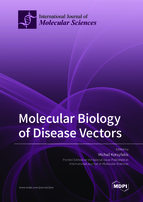Molecular Biology of Disease Vectors
A special issue of International Journal of Molecular Sciences (ISSN 1422-0067). This special issue belongs to the section "Molecular Microbiology".
Deadline for manuscript submissions: closed (31 August 2022) | Viewed by 30166
Special Issue Editor
Interests: biology of disease vectors; ectoparasite/host interaction; protease inhibitors; cystatin; arthropod; transcriptomics; proteomics; arthropod saliva; immunomodulation; hemostasis
Special Issues, Collections and Topics in MDPI journals
Special Issue Information
Dear Colleagues,
Arthropod disease vectors transmit not only serious diseases like malaria, but many other diseases as well, many of which are neglected to various extents. In most cases, a tripartite interaction is involved between the arthropod disease vector, the vertebrate host, and the vector-borne pathogens. The aim of this Special issue is to collect the latest data (and up to date information in the case of reviews) about the molecular and biochemical events that mediate this tripartite interaction. The contribution of data (coming for example from systems biology and molecular biology/biochemical approaches or reviews) is anticipated to improve our knowledge of the biology of any of the three key partners involved in vector-borne disease transmission, and/or of their intimate interactions. Specific subtopics to be included in this Special issue, but our interest is not limited to these subtopics, are the following: disease vector–vertebrate host interactions, vector-borne pathogen interactions with the disease vector and the vertebrate host, molecular biology/microbiology of arthropod-borne pathogens, vertebrate host response to arthropod-borne pathogens, and molecular biology of disease vectors (e.g. arthropod immunity, blood meal digestion, oogenesis/reproduction, olfaction and other sensory cues, and insecticide resistance).
Dr. Michail Kotsyfakis
Guest Editor
Manuscript Submission Information
Manuscripts should be submitted online at www.mdpi.com by registering and logging in to this website. Once you are registered, click here to go to the submission form. Manuscripts can be submitted until the deadline. All submissions that pass pre-check are peer-reviewed. Accepted papers will be published continuously in the journal (as soon as accepted) and will be listed together on the special issue website. Research articles, review articles as well as short communications are invited. For planned papers, a title and short abstract (about 100 words) can be sent to the Editorial Office for announcement on this website.
Submitted manuscripts should not have been published previously, nor be under consideration for publication elsewhere (except conference proceedings papers). All manuscripts are thoroughly refereed through a single-blind peer-review process. A guide for authors and other relevant information for submission of manuscripts is available on the Instructions for Authors page. International Journal of Molecular Sciences is an international peer-reviewed open access semimonthly journal published by MDPI.
Please visit the Instructions for Authors page before submitting a manuscript. There is an Article Processing Charge (APC) for publication in this open access journal. For details about the APC please see here. Submitted papers should be well formatted and use good English. Authors may use MDPI's English editing service prior to publication or during author revisions.
Keywords
- disease vector biology
- arthropod
- vector-borne disease
- hematophagy
- immune response to vector-borne pathogens
- arthropod immunity
- disease vector–pathogen interaction
- disease vector–vertebrate host interactions
- disease transmission
- disease vector development
- insecticide resistance







